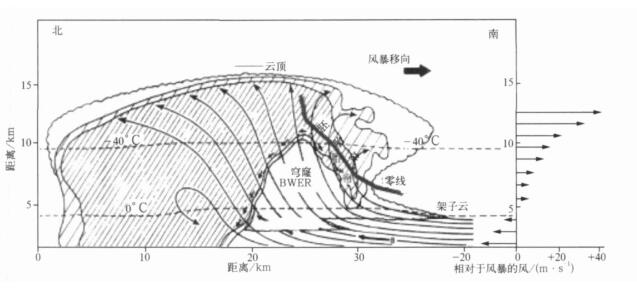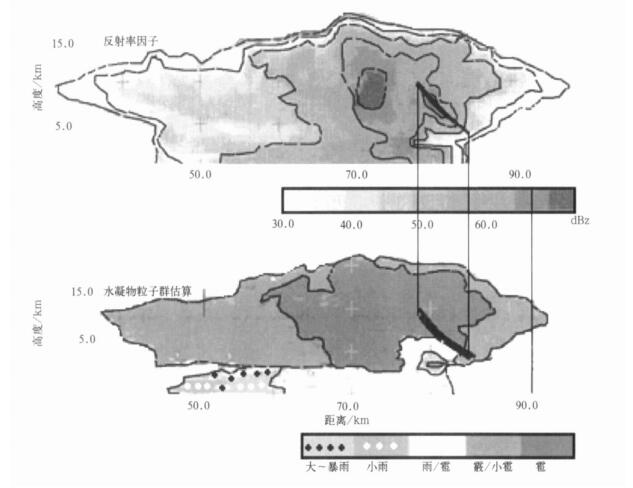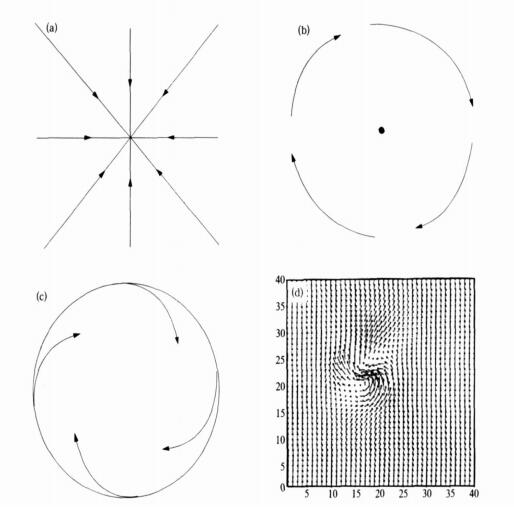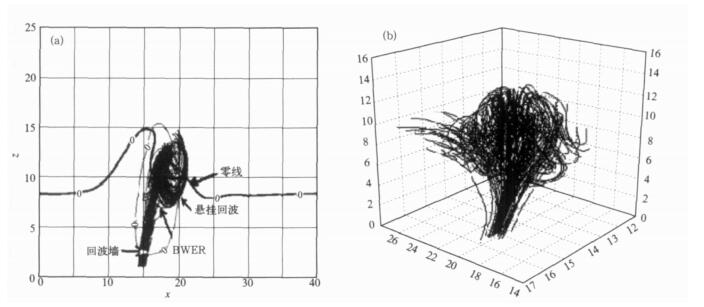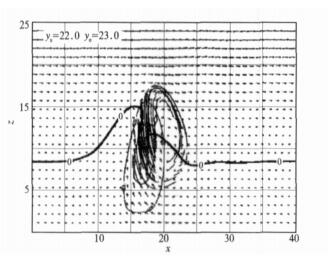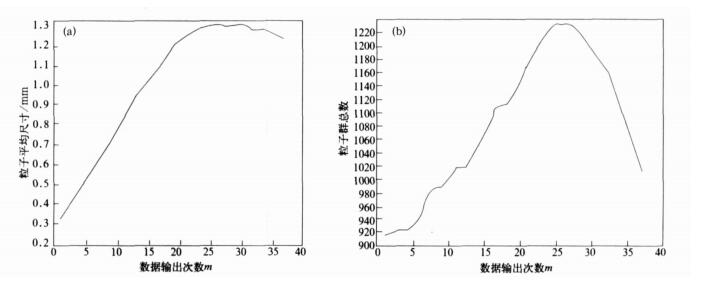强对流云中“穴道”的物理含义和应用
Physical Meanings of "Cave Channel" in Strong Convective Storm with Its Application
-
摘要: 自提出在冰雹云中存在“穴道”-“零域”结构以来, 已有一批相关模拟和观测研究论文发表, 进一步深化了对这一现象的理解, 同时在探讨和应用中也显现出一些问题或疑问:如“穴道”-“零域”结构存在的条件, 阵雨性对流云中是否也有类似结构, 前人的研究中为何未明确指出这种结构, 在应用中如何判识“穴道”-“零域”等。该文以观测实例和数值模拟作了回答, 并系统地探讨了“穴道”-“零域”的物理意义和应用要领, 明确了以下几点:从本质上来看“穴道”-“零域”具有的功能是云中宏、微观运动量场之间相互作用的表现; 强对流云中一些特殊的雷达回波结构, 如有界弱回波区 (BWER)、无界弱回波区 (WER) 或悬挂回波 (OE), 则是这种相互作用的产物; 只有在云中的气流速度与粒子的末速大小相当时, 这种相互作用才起重要作用, 粒子的末速比气流的速度过大或过小, 其作用反映弱; 对“穴道”-“零域”物理含义的探讨可深化对雷达产品的动力及物理意义的认识, 这对于在灾害性———高影响天气的临近预报中去寻找特征指标和判定防雹增雨作业的部位、时机等提供了科学依据。Abstract: Since the "cave channel"(CC) or "zero region"(ZR) structure is suggested, several papers are published on this title. The understanding of the physical meanings of CC or ZR is deepened by these papers, but in principle and application there are questions to answer or clear up, such as the conditions of formation of CC or ZR in strong storm, the analogous CC in rain-storm, why previous studies do not indicate the existence of CC, how to find CC structure in practical application etc. These questions are answered and the meanings are further understood by observation facts and numerical simulations. It is shown explicitly as the following. The CC or ZR structure is the results of the interaction between cloud's macro-flow field and cloud's micro-particle terminal velocities in nature. Some special structure of radar echo is BWER (bounded weak echo region), WER (weak echo region) or OE (overhang echo), it is the product of the interaction too. The interaction can play very important role only when the terminal velocity of particles is equivalent to the velocity of airflow. If the terminal velocity of particles relatively is too small or too large the effects of this interaction are very weak. The study of this interaction can deepen the understanding of the dynamical and physical meanings of the radar products, it is much necessary to find the characteristic criteria for now-casting of high-impact weather and in weather modification.
-
图 1 “穴道”示意图 (a), 3个长成冰雹的粒子循环运行增长轨迹 (b), 1个长成冰雹并向“穴道”集中的大粒子循环运行增长轨迹的二维图 (垂直于剖面的格点坐标:y=22;*表示粒子出发位置; 虚线是上升气流速度等值线)(c), “零域”中上升气流速度及粒子平衡或平均位置 (d)
Fig. 1 (a) Schematic of "cave channal"(CC), (b) the 3D growth-travel trajectories of three large hailstones growing up, (c) the 2D growth-travel trajectories of a large hailstones concentrated to the "CC"(projection to the vertical cross section, y=22;* represents the starting loation; dashed lines present trajectories projected to the section), (d) the profile of verticle wind speed and particles at the equilibrium state with their terminal velocities respectively
图 4 强对流云旋转对流流型的优选演化示意图
(a) 纯辐合, (b) 纯旋转, (c) 理想的强辐合和强旋转, (d) 实际和最优的强辐合和强旋转
Fig. 4 The evolution schematic of a strong convective and rotary airflow pattern which is optimal for the formation and maintenance of hailstorm
(a) full convergence, (b) full rotation, (c) strong convection and rotation in ideal, (d) strong convection and rotation in natural and in optimal
图 6 粒子末速比原有末速减少一半时的模拟, 在y=22~23区间内, 340个长成大粒子的增长运行轨迹在区间内的轨迹线段分布
Fig. 6 Same as in Fig.5a, but for the terminal velocities of partices equal the half as much as normal terminal velocity
-
[1] 许焕斌, 段英.冰雹形成机制的研究———并论人工雹胚与自然雹胚的"利益竞争"防雹假说.大气科学, 2001, 25(2):277-288. http://www.cnki.com.cn/Article/CJFDTOTAL-DQXK200102016.htm [2] 许焕斌, 段英.强对流 (冰雹) 云中水凝物的积累和云水的消耗.气象学报, 2002, 60(5):575-583. http://www.cnki.com.cn/Article/CJFDTOTAL-QXXB200205007.htm [3] 康风琴, 张强, 马胜萍, 等.青藏高原东北边缘冰雹形成机理.高原气象, 2004, 23(6):749-757. http://www.cnki.com.cn/Article/CJFDTOTAL-GYQX200406003.htm [4] Kang Fengqin, Zhang Qiang, Lu Shihua, et al. Validation and development of a new hailstone formation theory—numerical simulations of a strong hailstorm occurring over the Qinghai-Tibetan Plateau. Journal of Geophysical Research Atmospheres, 2007, 112, D0227, doi:10.1029/ 2005JD00627. [5] 朱君鉴, 郑国光, 王令, 等.冰雹风暴中的流场结构与大冰雹生成区.南京气象学院学报, 2004, 27(6):735-742. http://www.cnki.com.cn/Article/CJFDTOTAL-NJQX200406003.htm [6] 田利庆, 许焕斌, 王昂生.雹云机理新见解的观测验证和复现.高原气象, 2005, 24(1):77-83. http://www.cnki.com.cn/Article/CJFDTOTAL-GYQX20050100B.htm [7] 贾惠珍, 寇书盈, 孟辉, 等.强对流云新概念在积云人工增雨作业中的应用.气象科技, 2005, 33(增刊):7-10. http://www.cnki.com.cn/Article/CJFDTOTAL-QXKJ2005S1001.htm [8] 孟辉, 寇书盈, 贾惠珍, 等.应用"零域"概念进行对流云防雹 (增雨) 作业.气象科技, 2005, 33(增刊):11-13. http://www.cnki.com.cn/Article/CJFDTOTAL-QXKJ2005S1002.htm [9] Browning K A, Foote G B. Airflow and hail growth in supercell storms and some implications for hail suppression. Q J R Meteorol Soc, 1976, 102:499-533. doi: 10.1002/(ISSN)1477-870X [10] Zrnic D S, Ryzhkov A, Straka J, et al. Testing a procedure for automatic classification of hydrometeor types. J Atmos Ocean Technol, 2001, 18:892-913. doi: 10.1175/1520-0426(2001)018<0892:TAPFAC>2.0.CO;2 [11] 刘式达, 刘式适, 付遵涛, 等.从二维地转风到三维涡旋运动.地球物理学报, 2003, 46(4):450-454. http://www.cnki.com.cn/Article/CJFDTOTAL-DQWX200304003.htm [12] 刘式适, 付遵涛, 刘式达, 等.龙卷风的漏斗结构理论.地球物理学报, 2004, 47(6):959-963. http://www.cnki.com.cn/Article/CJFDTOTAL-DQWX200406003.htm [13] Miller L J, Tuttle J D, Foote G B. Precipitation production in a large Montana hailstorm:Airflow and particle growth trajectories. J Atmos Sci, 1990, 47:1619-1646. doi: 10.1175/1520-0469(1990)047<1619:PPIALM>2.0.CO;2 [14] Heymsfield A J. Case study of a hailstorm in Colorado.Part Ⅳ, Graupel and hail growth mechanisms deduced through particle trajectory calculation. J Atmos Sci, 1983, 40:1482-1509. doi: 10.1175/1520-0469(1983)040<1482:CSOAHI>2.0.CO;2 [15] Paluch I R. Hailstorms of the Central High Plains I, Chapter 8, 1982:195-206. [16] Nelson S P. The influence of storm flow structure on hail growth. J Atmos Sci, 1983, 40:1965-1983. doi: 10.1175/1520-0469(1983)040<1965:TIOSFS>2.0.CO;2 [17] 许焕斌, 段英, 刘海月.雹云物理与防雹的原理和设计———对流云物理与防雹增雨 (第二版).北京:气象出版社, 2006: 117-127. [18] 许焕斌, 田利庆, 段英.关于积云增雨和实施方案的探讨.气象科技, 2005, 33(增刊):1-6. -


 设为首页
设为首页 加入收藏
加入收藏


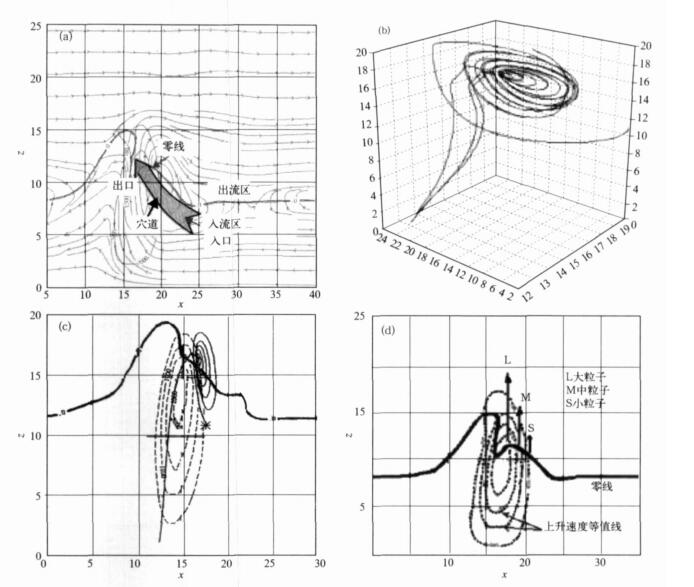
 下载:
下载:
